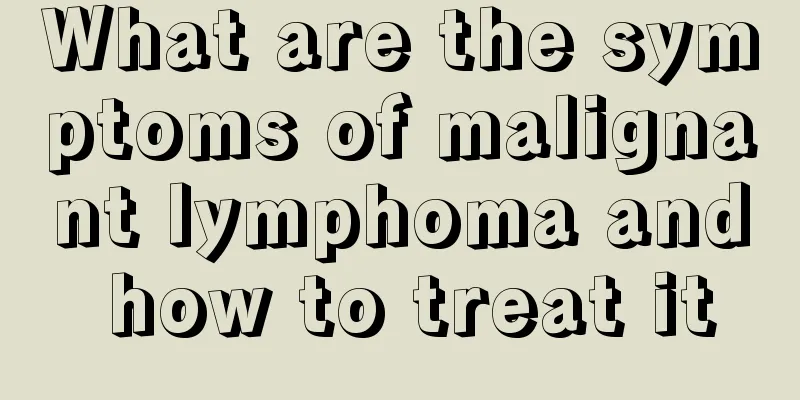What are the symptoms of malignant lymphoma and how to treat it

|
Lymphoma is a very difficult cancer to treat, and symptoms may be present all over the body. Since lymph nodes are located in different parts of the body, do you know the symptoms of lymphoma? How is it treated? The clinical features are painless, progressive lymphoid tissue hyperplasia, especially of superficial lymph nodes, often accompanied by splenomegaly, anemia, fever, and advanced malignant disease. Although malignant lymphoma is relatively rare in my country, new cases have increased year by year in recent years, and its incidence and mortality rate rank first among all malignant tumors 11-13. This disease can occur at any age, but most patients are young, more male than female, and higher in urban areas than in rural areas. For patients with lymphoma, relevant doctors should choose different treatment plans according to the patient's physical condition, pathological type and clinical stage to achieve the purpose of cure. The importance of the first treatment is particularly emphasized here. If the treatment is not appropriate, future continued treatment will be particularly difficult and the efficacy will be reduced. Therefore, once diagnosed with lymphoma. It is best to find a general specialist for treatment, which is also the key to cure. Commonly used treatment methods are: 1. Combination chemotherapy: Most lymphomas require combination chemotherapy. Common regimens are MOPP nitrogen mustard, vincristine, methylpyrene, sedation ABVD doxorubicin, bleomycin, vinblastine, azathiocarbamide, CHOP cyclophosphamide, doxorubicin, vincristine, sedation BACOP bleomycin, doxorubicin, cyclophosphamide, vincristine, sedation, and some require high-dose methotrexate, cytarabine, and podophyllotoxin. 2. Radiotherapy: CO-60 or accelerator is commonly used, with a dose of 40-60Gy/4-6 weeks, depending on the condition. 3. Immunotherapy: After radiotherapy and chemotherapy for some lymphomas, interferon treatment can improve the cure rate. 4. Rituximab is effective against monoclonal antibody CD20-positive B-cell malignant lymphoma. |
<<: What are the pathological classifications of nasopharyngeal carcinoma
>>: What does stage three liver cancer mean?
Recommend
What causes liver cramps? Be alert to these 3 diseases when you have liver pain
The liver is the main metabolic organ of our body...
How many types of allergic purpura are there?
Allergic purpura is a common clinical disease, wh...
Effects and side effects of targeted therapy for renal cancer
The treatment of renal cancer is mainly radical n...
How to wash off walnut oil
The oil content in walnuts is relatively high. If...
Precautions for pregnant women with kidney cancer
What should I do if I get kidney cancer while try...
Is it really good to use eye drops for a long time?
With the advancement of technology and the emerge...
What are the preventive measures for patients with pituitary tumors
Everyone knows that once some diseases are contra...
What's going on with a missing piece of hair?
In real life, many people are prone to missing pa...
Can left bronchial lung cancer undergo surgery?
Can left bronchial lung cancer be operated on? Le...
Common knowledge about lung cancer, and a correct understanding of folk remedies for treating lung cancer
Since lung cancer is difficult to treat, many lun...
The cause of lung tumor is related to diet
Most lung tumors originate from the bronchial muc...
How long can patients with advanced lung cancer generally live?
Lung cancer is one of the malignant tumors with t...
What are the rules for lighting incense at home
China is a country with a large number of religio...
What are the symptoms of advanced esophageal cancer
Esophageal cancer is a common disease that seriou...
Are your fingertips numb and swollen?
In daily life, fingers are one of our more import...









